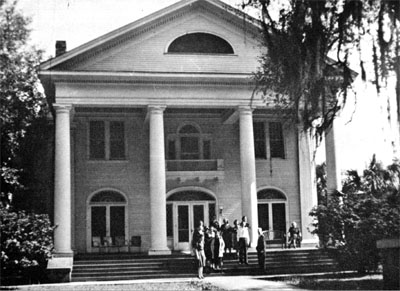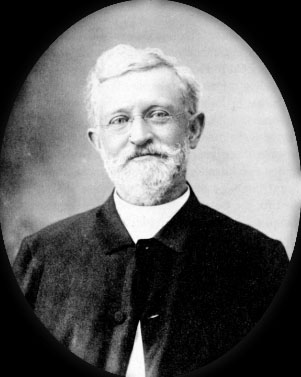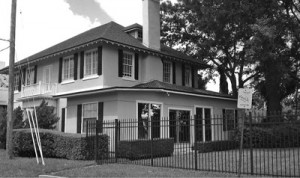Balancing progress with historical preservation at “Miss Margie’s” house
Hallmark Partners’ Bishopgate Lane development under RAP’s scrutiny
By Steve DiMattia
Resident Community News
How do you move forward without demolishing the past?
That dilemma often sparks debate in historic districts and may face Hallmark Partners in their development of a notable Riverside street.
Bishopgate Lane runs into the St. Johns River off Riverside Avenue a block from The Cummer Museum of Art and Gardens. The river-end of the street is quiet with little traffic beyond those capitalizing on river access to fish or enjoy the idyllic view and those visiting either The Robin Shepherd Group or the Duval County Medical Society, which anchor Bishopgate Lane.
Both buildings go back a ways – Shepherd to 1947 and DCMS even further to 1926 – offering a glimpse into the street’s diminished history. As Hallmark moves forward with the development of a 16-story, 55-unit luxury condominium called Beacon Riverside on the Shepherd site, and a rumored 12-unit multi-family development on the DCMS site, that history is at risk of vanishing altogether.
And this street does have history.

Bishop Weed’s mansion at 1128 Riverside Ave (re-addressed to 1035 in 1929) on the corner of Bishopgate Lane
It was named “Bishop Gate Lane” in 1910 to honor Bishop Edwin Gardner Weed, according to Interesting Facts About Leading People and Families of Duval County. Weed was the third Episcopal Bishop of Florida (1886-1892) and lived in a mansion at Riverside Avenue and Bishopgate Lane from 1910 until his death in 1924. He was a revered man who, a June 11, 2005 Florida Times-Union article noted, was worthy of a “funeral of grand proportions…with many visiting church and government dignitaries. He was buried at Evergreen Cemetery with a 75-voice choir accompaniment.”
Weed’s daughter, Margaret “Miss Margie” Weed is listed in city directories as living with him in the mansion. While never attaining the public stature of her father, she was nonetheless “active in community, religious and patriotic affairs,” most notably serving 12 years with Duval County Board of Public Instruction and as president of Episcopal Women’s Auxiliary of the Diocese of Florida, according to her Aug. 12, 1961 Times-Union obituary.
After Weed’s death, Miss Margie built a house on the river, which is the current DCMS building at 555 Bishopgate Lane. She lived there from 1929 until her death in 1961, selling it to DCMS that same year for $25,000, according to Florida’s Pioneer Medical Society: A History of the Duval County Medical Society & Medicine in Northeast Florida. They have owned it since, renovating the two-story, 5,500-square-foot residence into office space in 1985.
Now, an ownership change might mean the end of Miss Margie’s home.
Hallmark’s Alex Coley verified Hallmark has the property under contract planning an October closing, and DCMS is scheduled to move to Riverplace Tower on the Southbank Oct. 15, according to Brian Campbell, DCMS executive director.
An Aug. 14 Jacksonville Business Journal article by Ashley
Gurbal Kritzer reported, “There are no plans for the land, other than use as a staging area during the construction of Beacon [Riverside].” However, City Planning Division Chief Folks Huxford thinks Hallmark is planning a 12-unit multi-family building on the site, based upon an August meeting he had with Hallmark Senior Vice President Coen Purvis. He understood the building would be demolished, though Huxford has seen no renderings or plans for the project.
“We do not have our thoughts formulated on that process yet,” Coley said, deferring discussion of Hallmark’s intentions for the site until after the purchase is finalized. The building, located within the urban transition area, falls outside the Riverside/Avondale Historic District and can be demolished without review by the Jacksonville Historic Preservation Commission. “Hallmark Partners would like to proceed under the current rules and regulations, thus avoiding a rezoning,” Huxford said.
Talk of demolition raises red flags for Riverside Avondale Preservation.
“How could the city support tearing down historic homes in the urban core, whether in the historic district or not, especially with no clear understanding of the intended use after demolition?” asked RAP Executive Director Carmen Godwin. “At the very least Hallmark should be encouraged to move the home to another location.” Godwin hopes to soon meet with Hallmark’s partners.
Joel McEachin, City of Jacksonville’s Planning and Development Department supervisor of historic preservation, said placement on the National Register of Historic Places might be an alternative to moving the building and would prompt a demolition delay while under review by the preservation commission. A building has to have architectural, historical or archaeological significance to be designated a local landmark.
“This building does relate in terms of age, style and placement,” McEachin said.
Whether Miss Margie’s home would qualify for landmark status or relocation remains to be seen. A walk through shows no obvious deterioration, but Campbell said the driving factor in the medica
l society’s decision to move is the poor condition, noting a leaking roof, structural gaps and possible termites. Wayne Wood, RAP’s founder, said he is not certain of the house’s architectural significance and noted that Miss Margie “was not a terribly historical person.” Nonetheless Godwin said she thinks landmark status or relocation is worth exploring.
Beyond Miss Margie’s house lie two bigger issues for Wood.
“My biggest concern with two developments is too much density at the end of a dead end street. Also, the neighborhood would want to preserve access to the river, so they would have a heated fight on their hands if their plans include closing the street,” Wood said. “We just hope they’ll be good neighbors.”
Across the street from Miss Margie’s house the Shepherd building is slated for demolition to make room for Beacon Riverside. Bishop Weed’s mansion changed hands several times over the years – including ownership by Wayne Wood’s grandparents, 1937-1961, when it was a boarding house – until ultimately succumbing to demolition in the late 1960s.
“The historic fabric of that corner of the neighborhood is decimated, overtaken by modern buildings,” Wood said.
Hallmark’s potential decision to either demolish Miss Margie’s house – furthering that decimation and breaking the final thread connecting Bishopgate Lane to a piece of Jacksonville’s past – or save it places them at the crossroads of balancing progress with preservation.
Catherine Currier, Jacksonville Public Library associate, provided invaluable research assistance for this article.






 (2 votes, average: 4.00 out of 5)
(2 votes, average: 4.00 out of 5)

